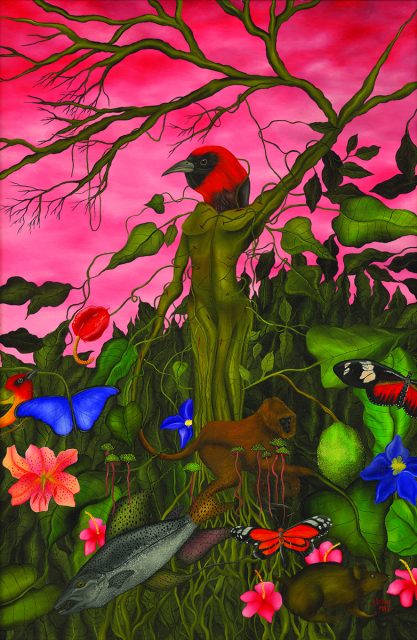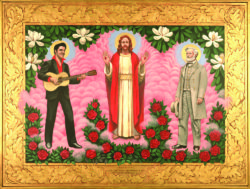Winter 2016
Profligate Beauty
An exhibition showcased Southern storytelling with over seventy pieces from the Ogden's permanent collection
Published: December 8, 2016
Last Updated: January 11, 2023

Gift of the Roger H. Ogden Collection.
Trinity–Elvis and Jesus and Robert E. Lee by Claude Broadway, 1994.
The quote inspired the Ogden Museum of Southern Art’s exhibition, Profligate Beauty: Selections from the Collection, which was on display through September 2017.
To work in a museum is a strange world. We are art enthusiasts constantly surrounded by art. At times this overabundance of beauty – some sorrowful, some strange, some simple, and some gorgeous in its simplicity – can be overwhelming. Ogden Museum’s curator of the collection, Bradley Sumrall, describes his reading of Mann’s quote as less of an epiphany than something akin to synesthesia.
“With each word I read I saw painting after painting. I was drawn to that idea of profligate beauty – how one can be reckless with beauty. Being at the museum everyday you’re constantly inundated with art, it is almost reckless,” says Sumrall, “I wanted to translate that feeling into this exhibition and have it be overwhelming in its storytelling.”

Encounter III: Nest by Alan Gerson, 2008. Gift of the Artist. Related Entry: Alan Gerson
Prolifigate Beauty presented the best of Southern storytelling through a collection of old museum favorites, as well as new acquisitions that have never been displayed at the Ogden.
One of those old favorites is Clyde Broadway’s Trinity – Elvis and Jesus and Robert E. Lee. As residents in our city and region reexamine their relationship with traditional icons of the South, Broadway’s piece, so definitive of his narrative style of painting, allows us to approach the subject without judgment, furthering the conversation without taking a side. The painting is a prime example of Mann’s concept of living in that nexus between myth and reality. As children of the South, our bedtime stories are mixed with Creole myths, Confederate ghosts and Christian lessons, and in our daytime the vocabulary of these different ideas can often become one connected language. In Broadway’s piece we see a religious figure, a pop-culture figure, and an historical figure as equals, with halos on their heads harkening back to iconographic altar pieces of the past. It is at once provocative and reserved – something that can also be said of the South.

From the Vine to the Vein by Jacqueline Bishop, 1992. Gift of the Roger H. Ogden Collection. Related Entry: Jacqueline Bishop
A recent acquisition for the museum, Alan Gerson’s Encounter III: Nest, is an imaginative painting of a dinosaur nest in a lush, primeval forest. Colorful and large, the painting is a prehistoric take on the Southern obsession with history. Gerson imagines what the world would have looked like for someone exploring it at that time, someone who had no knowledge of the future of this planet and or its inhabitants. The result creates a double narrative for the viewer: in one sense you are the viewer looking at the painting, and in the other you are a figure from the past encountering a strangely beautiful new world. Gerson’s piece does what history cannot: it transports you to that time.
Perhaps most evocative of the theme of this exhibition is Jacqueline Bishop’s From the Vine to the Vein. One cannot discuss the creative spirit of the South without mentioning its lush and diverse landscape. As Mann notes, what is reckless is the physicality of the South. So much of the art from the region comes from a life set against the backdrop of red hills and flat deltas, green bayous, black lakes and kudzu-framed highways. Bishop’s painting brings to the forefront this concept of the interconnectedness of humanity and nature. Part of the natural world is transformed into a body. The painting, terrifying and beautiful, presents nature as a martyr, a natural Saint Sebastian. Both gothic and contemporary, of the piece evokes the magical-realism of writers like Lewis Nordan or Gabriel Garcia Marquez. Again we witness this “mishmash amalgam of sorrow, humility, honor, graciousness, and renegade defiance play[ed] out against”—or in this case through—“a backdrop of profligate physical beauty.”
There were far more pieces than these showcased in Profligate Beauty. Over seventy of the most important works from the museum’s permanent collection were on display until September 2017, furthering the Ogden Museum of Southern Art’s mission to tell the story of the South.

